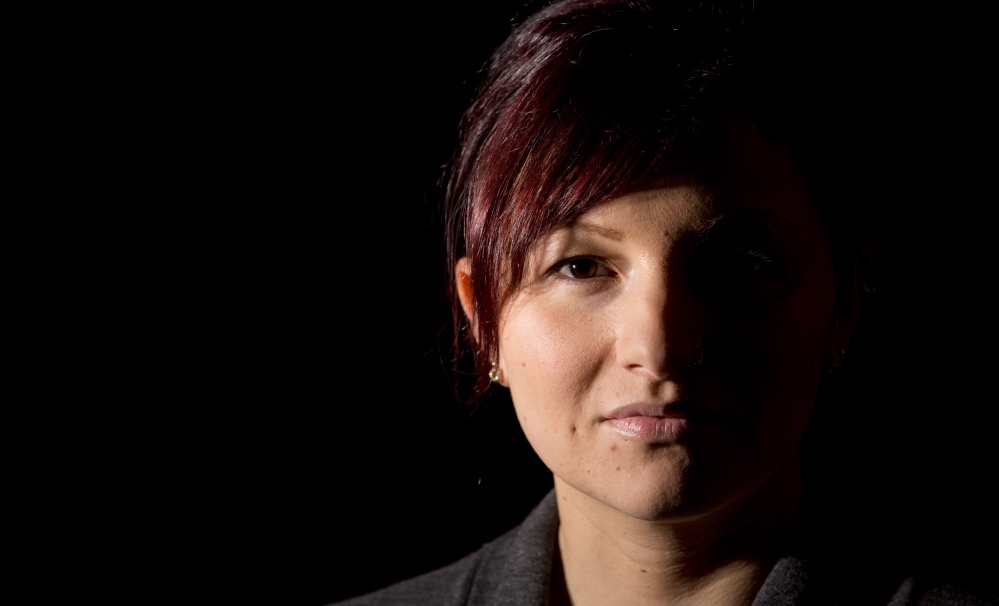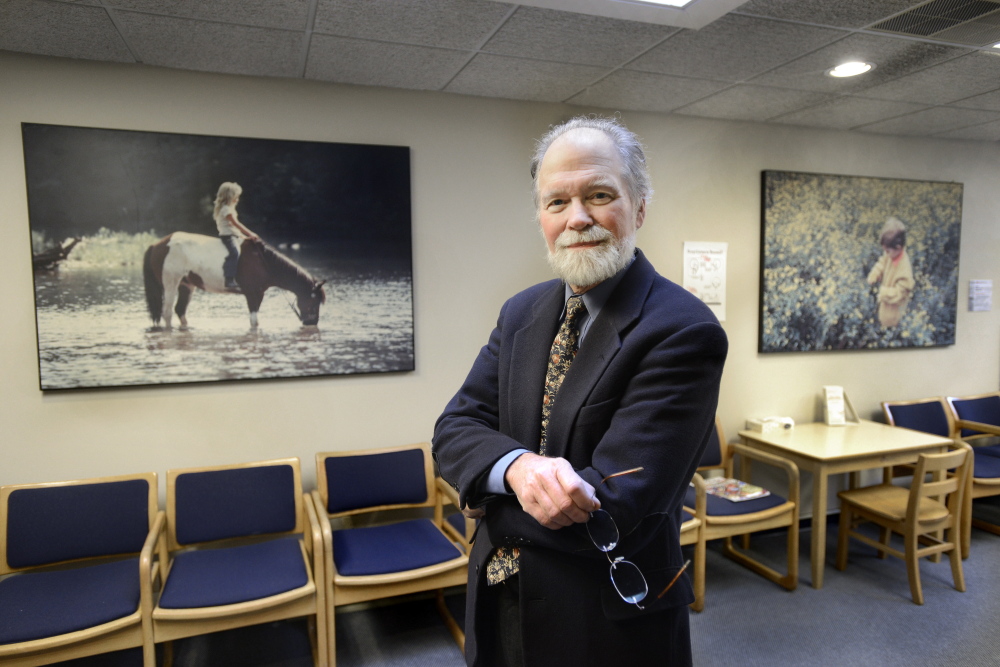When Tiffany Martinez goes to work at her new job in downtown Portland, she counsels mental health clients and prescribes medicine to treat hallucinations, major depression or other severe symptoms of mental illnesses. But while Martinez is making it as a young professional in Maine’s largest city – her fourth-floor office overlooks Monument Square – she said every day she realizes what could have been. Martinez, who previously was at risk for developing a severe mental illness, was part of a groundbreaking mental health program started at Portland’s Maine Medical Center that’s now being replicated in several states.
Martinez, 27, is a psychiatric nurse practitioner, but had she not received help at an opportune time, she said, she could now be suffering from acute schizophrenia or another illness, unable to hold down a good job or live a normal life.
Instead, she obtained her master’s degree, landed a great first job and is on the path to maintaining an upper middle class lifestyle.
“Sometimes I can’t believe it happened, that I was in the right place at the right time. I feel like I could have just as easily slipped through the cracks and not gotten the help,” said Martinez, who often flashes a confident grin. “I just trusted that I was with the right people.”
Martinez was treated by mental health professionals working for a program started at Maine Medical Center that has become a national model for early detection and treatment of mental illness. The Portland Identification and Early Referral program has been on hiatus for four years in Maine but will likely be restarted this year, officials said, with the potential to help about 100 people per year.
Meanwhile, PIER has gained a foothold in several states – including California – and as it expands it has attracted national media attention, including in The New York Times and Washington Post and on National Public Radio.
The PIER program, begun in 1999 at Maine Med, has migrated to several other cities, including San Diego; Ypsilanti, Michigan; Glen Oaks, New York; and Salt Lake City. The Robert Wood Johnson Foundation, which funds health-related programs, gave the program $17 million for it to be launched in other parts of the country.
Dr. William McFarlane, the Maine Medical Center psychiatrist who researched and created the PIER system, now spends much of his time traveling to various parts of the country, teaching others how to implement the model.
“This is very much a Maine product. It’s being used all over the country,” McFarlane said. “For instance, we are now in just about all the major population centers in California, except for Los Angeles. We’re expanding to Delaware and Philadelphia.”
McFarlane said Martinez’s story is typical – she started having mental health problems, but they had not yet turned severe. That’s the best time to treat mental illness, he said.
“I think people believe that suddenly overnight you go crazy. Nothing could be further from the truth. It’s a slow process that takes years,” McFarlane said. “It’s like a progression, kind of like when you get the flu. The first day you think you’re not that sick, on the second day you’re thinking, ‘Whoa, I really have something here,’ and on the third day you’re in bed all day. Mental illness is like that, but it doesn’t progress as fast.”
While Martinez was a student at the University of Southern Maine in the mid- to late-2000s, she started isolating herself and hearing voices, perhaps triggered by the transition of moving from her hometown of Eastport in Washington County to Portland. Her grades tanked, she felt paranoid and started having strange thoughts, like the trees were going to fall on her.
“I had this feeling of hopelessness,” Martinez said. “I knew something was wrong with me, but I was afraid of what it was. I didn’t know what was going on.”
MEDICATION, COUNSELING
Instead of ignoring the problems, at the urging of school counselors and friends, she joined the PIER program. Diagnosed with early onset of psychosis, she was prescribed medication and underwent extensive counseling that lasted for five years before she completed the program in 2009. Martinez said she could have developed schizophrenia had she not received early treatment.
Martinez credits PIER with preventing her mental illness from becoming severe, having a major psychotic episode or perhaps hospitalization. Instead, she earned her master’s degree and is now a psychiatric mental health nurse practitioner at Spurwink, a mental health services agency based in Portland.
Martinez said she can relate to her clients because of what she went through, and she often understands what they are feeling, even when they have difficulty communicating it to friends and family.
“A lot of people just want someone to listen to them,” Martinez said. “When you do this kind of work, you have to be passionate about it. You can’t do it 80 percent. It’s all or nothing.”
McFarlane said in the 1990s he came across research suggesting that early detection worked in treating mental illness, and he since has spent his working life developing the program.
The PIER system has held up to research scrutiny in publications such as Psychiatric Services, and its methods are supported by the National Alliance on Mental Illness and the U.S. Substance Abuse and Mental Health Services Administration.
“Why should we treat mental illness different from other diseases, where we know early detection is the most effective?” McFarlane said. “If you wait for a psychiatric crisis to occur, the disease has progressed, and while it’s possible to treat, it’s much more difficult to control.”
IDENTIFICATION, REFERRAL
So, how can mental illness be detected before a crisis occurs?
McFarlane said for schizophrenia, which often manifests itself in adults in their 20s, research shows that the disease actually often begins to affect the brain in high school or early college. So the PIER program networked with high school and college principals, school nurses, guidance counselors and primary care doctors.
“It’s not hard to find them. If you ask the school counselors, and tell them what too look for, they can tell you immediately who is at risk,” McFarlane said.
McFarlane said the symptoms are subtle but not so hard to spot if professionals know what to look for.
“In general, the symptoms are much more infrequent, subtle, less disturbing and less intense,” McFarlane said. “One of the first things we notice is an unexplained loss of functioning – someone who does well in school and starts flunking many tests, or a basketball player who one year is a college prospect and then suddenly can’t dribble the ball.”
He said hearing voices, unexplained and unreasonable fears and withdrawing from society are also common.
Once people are identified, they are then referred to treatment with either a PIER psychiatrist or – if they have a mental illness such as bipolar disorder or post-traumatic stress disorder but are not in the early stages of a psychotic mental illness – with other mental health providers. McFarlane said some of the people who were not suffering from a psychotic illness nevertheless could have developed more severe diseases later, and early treatment helps all of the patients.
Studies are backing up the PIER system.
In Maine, symptoms turning into a “full-blown psychotic diagnosis” fell 26 percent in the Portland area over a six-year period in the 2000s, but rose 8 percent in other parts of the state, where the PIER program was not in place, according to a study published in October in Psychiatric Services scholarly journal. While about 40 percent of those diagnosed with schizophrenia nationally are hospitalized, in Greater Portland the rate dropped to 15 percent, and that can be attributed to the PIER program, according to the research.
POSITIVE RESULTS IN MICHIGAN
In Michigan, the program has a stellar reputation for preventing severe mental illness in Ypsilanti, and it is catching on in other parts of the state, said Elizabeth Spring, program administrator for Youth and Family Services in Washtenaw County.
Spring said she has trained mental health officials in Detroit and other parts of southeast Michigan, and Lansing, the state capital, has shown interest as well. In Washtenaw County, they’ve run the program for nearly 15 years, expanding it in 2007 to reach more people. She said about 60-75 people per year with the potential to have a severe mental illness go through the program.
“It’s a very intense program, but you need to get a hold of the illness before people end up in the hospital,” Spring said. “It’s really made a big difference in getting help to a lot of people.”
The PIER program in Maine ran out of funding in 2011, but McFarlane said he’s applying for a $1.4 million, five-year grant from the state to restart it. If successful, it would relaunch this spring, in Cumberland County and possibly Androscoggin and York counties.
The grant would pay to hire four or five people, including a psychiatrist, social workers, an occupational therapist and employment specialist. In addition, Maine Med has already landed a separate $150,000 two-year grant for education and outreach efforts to make the general public and health professionals aware of the PIER program.
McFarlane said since PIER has been recognized nationally as a success, he hopes one day it or a similar program will become the standard method of treating mental illness.
“I want it to not be an alternate program, but just the way we treat not only schizophrenia and psychotic illnesses, but major depression, bipolar disorder, even obsessive-compulsive disorder,” McFarlane said.
Send questions/comments to the editors.





Comments are no longer available on this story